There was a lot of pressure. I knew if we explained it poorly, we could lose good customers. But if we handled it with care, we could actually build even more trust by showing them exactly what they were getting for their money.
Over the years, I’ve learned that how you communicate the change is just as important as the price increase itself. Customers don’t like paying more — that’s a given. But they can respect the decision when you are clear, honest, and transparent about it. What I’m sharing below comes from my experience with these tough conversations in different industries, from software to e-commerce, and it should help you keep your customers on board.
Table of Contents
-
Common Reasons for Price Increases
- Price Increase Justification
- Price Increase Letter Templates
- Sample Price Increase Letter Template
- How to Write a Price Increase Letter
- Price Increase Letter Examples
Common Reasons for Price Increases
In most cases, the reasons for an increase fall into a few specific buckets. It’s important to understand which one applies to you and explain it clearly. Your customers will be more receptive if they can connect the change to a real-world reason.
When Your Own Costs Go Up
This is the most common reason, especially in recent years. At Greenhouse, our business was scaling up quickly.
That growth meant we needed more of everything: more server capacity, a bigger support team, and better internal tools.
These are real costs. When we discussed the new pricing, I made sure to relate it to our need to maintain the excellent service and trust our customers relied on. This helped them see that the increase was for their benefit, not just our bottom line.
When the Product Is More Valuable
Your product or service is probably not the same as a year ago. I’ve managed price changes that were tied directly to new product features and offerings. For instance, when a platform adds new automation tools, more robust analytics, or very specific and useful integrations, the product itself is more valuable. Explaining a price change in terms of this new value helps customers see it as a continued investment. You’re not just charging more, you’re offering more, which echoes the principles in HubSpot’s guide to writing a great value proposition.
When You Need to Align with the Market
Market alignment is not just about price adjustments. From my role in support, it was about making sure our service offerings made sense. At Greenhouse, we realized there was a disconnect in our old model. Some of our legacy plans were getting premium-level support for a basic-tier price. This wasn’t fair to our higher-paying customers and, frankly, it wasn’t a sustainable model for my team.
A major part of my responsibility during the redesign was to analyze what our direct competitors were offering at different price points. I looked at everything from their response time guarantees, whether they offered phone support, what their onboarding process included, and so on. My job was to design new, tiered support packages that not only aligned with our new pricing but were also highly competitive. This meant that when we communicated the price changes, we could be very specific. We could show customers that their new price came with a clearly defined level of support that was as good as, or better than, anything else in the market. It wasn’t just an arbitrary price hike but a logical restructuring of value.
Resource suggestion: For practical tips on benchmarking and researching competitors, HubSpot offers in-depth guidance on competitive analysis and building a competitive matrix.
When Your Supply Chain Costs Change
At Skybound, running a global e-commerce operation means dealing with a volatile supply chain. We face constantly shifting logistics costs, a new era of international tariffs that are out of our control, and even price changes from our manufacturing partners.
From a support perspective, reacting to these shifts only creates frustrated customers. I try to focus on proactive communication. We create detailed articles for our public knowledge base that explain the realities of global shipping and tariffs. This way, when customers ask about a shipping cost, my team has a clear, consistent resource to share. It builds trust by being transparent about these complex external pressures and helps customers understand the real costs involved. Give your customers the context behind these external costs before they have to ask.
No matter your reason, the common thread is clarity. Before you do anything else, identify your specific “why” and build your entire communication strategy around it.
Price Increase Justification
One thing I’ve learned, customers don’t usually leave just because of a higher price. They leave when an increase feels unfair, unexplained, or disrespectful. A price change is a real test of the relationship you have with your customers, and how you handle it makes all the difference.
I’ve seen this play out many times, and my experience echoes something HubSpot’s CEO, Yamini Rangan, once said about their own pricing changes. She noted that “Some price optimizations were successful and others weren’t. But the ones that we communicated well were always value-driven.”
That insight perfectly summarizes the right approach. Your entire announcement should be built around the value the customer receives. When I’ve been involved in these announcements, I focused on proving that value through three key principles.
1. Radical Transparency
This means telling them the real “why.” Don’t hide behind vague corporate language like “to better serve you.” I always tell my support team to be specific and honest. If your server costs have gone up 30%, say that. If the increase is funding a specific, highly requested new feature, tell them what it is. People are reasonable and can spot a canned response a mile away. Even if you’re using AI, take the extra step to personalize the interaction. Authenticity and honesty build trust.
2. Relentless Focus on Value
Your communication should be less about your costs and more about their benefits. This is your chance to remind them why they chose you in the first place. Reiterate the core value they get from your product daily. Then, clearly connect the price increase to future value. For example, “This lets us build the new analytics dashboard you’ve been asking for.” You have to connect the dots for them, which is the central message in HubSpot’s value proposition templates.
3. Genuine Respect
Respect in this context is all about action. It means giving customers plenty of advance notice so they can budget and prepare, not springing it on them a week before billing. It means creating a simple way for them to ask questions, whether it’s an FAQ document or a dedicated email address. And it means acknowledging that this might be difficult news. A simple sentence like, “We understand this adjustment may impact you, and we wanted to give you as much notice as possible” shows you see things from their perspective.
Sticking to these principles has helped me keep customers through some major changes. It turns a risky financial announcement into a moment that can, believe it or not, actually make your relationship with your customers even stronger.
1. Contact them directly.
Imagine if your Spotify Premium bill increased from $9.99 to $14.99 per month without your knowledge or consent. You would be pretty mad, right?
It's unfair for a customer to suddenly find out there has been a price increase in their product. If a price increase occurs, go through your list of customers who use that product or service, and send a price increase letter notifying them of the change. If possible, address the letters to each customer to personalize the process.
Tom Edwards, founder of Bit Quirky Consulting, shares his thoughts on the difference a personalized message can make, "Personalizing your communication is crucial. I have always reached out directly via phone or even in person if possible, and followed up with a clear email. This shows you genuinely care about their business.

In the past, I have considered offering options like phased price increases and flexible pricing plans to make the transition smoother. Keep a positive and confident tone, emphasizing the value of your services. Encourage open dialogue, listen to their feedback, and be willing to make adjustments if necessary. By showing appreciation and maintaining high standards, you’ll reassure your customers that they’re making the right choice by staying with you."
2. Let customers know well in advance.
You should provide your customers with plenty of time to come to terms with the price increase. They may need to re-assess their budget or consider alternative options, so you should keep them in the loop once you're made aware of the situation. Additionally, encourage them to make one or more product orders before the price increase kicks in.
Edwards continues on to say, “The key is to communicate early and be transparent. Give your customers plenty of notice and explain the reasons behind the increase, whether it's due to rising costs or because you're enhancing your services. People appreciate honesty and are more likely to understand if they see why the change is necessary.”
3. Tailor messages to different customer segments.
Sam Hickson, CEO of TG Wireless - Wholesale Cell Phones, shares personal insight on the importance of differentiation, "I can say from experience that price changes have varying impacts on different users or clients. It’s very important to personalize your messages because, from my experience, a company often deals with various customers who engage with different products and services.
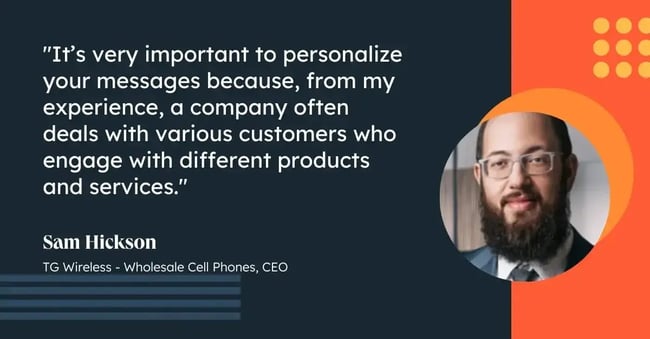
Some customers might be on paid subscription plans, while others could still be using free versions. You also might be serving both corporate clients and regular end-users, who are each at different stages of their customer journey. All these factors need to be considered when crafting a price increase letter."
Depending on the service or product that you offer, you need to meet your customers where they are, especially considering their individual needs. You can increase prices, but try to do so in a way that is feasible for varying budgets.
“I personally believe that it's important to categorize your clientele into distinct segments and tailor different versions of a price increase notice to each group. It should follow a different approach for each user segment, taking into account their specific needs and the subscription plan they currently have.”
4. Remind them that higher prices mean better quality.
The necessity for a price increase can be confusing for customers, especially if they've been purchasing the same product for months or years. It makes it vital that you stress the importance of product quality.
Typically, products increase in price to match higher operating costs, increases in hires, or increases in prices of needed materials. To ensure the same level of high quality, sometimes you have to raise the price.
Erika Friedrich, Operations Manager at A-Temp Heating & Cooling Inc. shares a quote, "Despite rising costs, it's crucial to maintain the guarantees you currently offer to maintain a high level of trust with your clients. Take time to emphasize the value they will continue to receive by detailing improvements in quality, new features, or additional benefits that justify the price hike.
5. Explain the reasoning behind the price increase.
Craig Willis, CEO of Skore, explains why you should lead with reasoning, “Explain why you need to increase prices and provide examples of what's driving it. If your staff costs are rising, say so. If it's infrastructure, provide an example of how much that has gone up, etc. No customer expects you to run your business at a loss, so they will appreciate the honesty. If they don't care, are they the type of customer you want?”
To make it clear that you're raising the prices to maintain the quality of the product, you should explain what caused the price increase. For instance, as some raw materials become increasingly scarce and expensive, companies that utilize these materials are forced to increase the prices for products that use them. Laying that out to customers will prove your willingness to be transparent.
6. Ensure the entire organization is aware of the price increase before announcing it to customers.
It would be embarrassing for a frontline worker to accidentally charge a customer the wrong price because their company failed to notify them of a change. Even if all employees were made aware of the situation, they should all be on the same page in terms of the cost difference, the reasoning, and the logistics moving forward. That way, your company has a consistent voice on the matter.
7. Offer flexible pricing structures to maintain inclusivity.
Virginie Glaenzer, Fractional Chief Marketing Officer at AcornOak, emphasizes the value of accommodation with the quote, "Communicate with empathy, understanding the sensitivity of price adjustments, and provide channels for feedback to foster a dialogue.
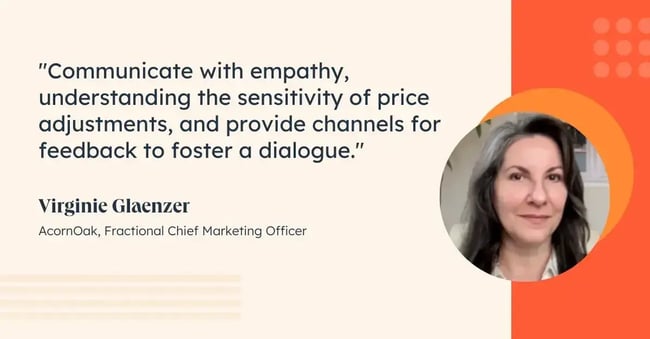
Also, consider maintaining current rates for existing customers temporarily as a gesture of loyalty. Finally, monitor reactions and adapt strategies as necessary to maintain trust and satisfaction. This sophisticated approach not only manages the price transition but also enhances the overall customer experience."
Reward your current loyal customers with a perk only they have access to at the beginning of the price change. While no customer is excited to see prices go up, they will feel more appreciated getting an exclusive discount amidst the change.
8. Allow customers to contact with further questions or concerns.
You want to be sure your customers receive all the information they require. A lack of information could cause them to churn to a competitor with lower prices. Reassure them that they can always reach out to anyone in your company, including high-level executives, with any more questions or concerns that come up regarding the price increase.
Cari O'Brien, founder of Custom Content Solutions LLC, shares, “Encourage customers to respond with any questions or concerns and commit time on your calendar to speak with anyone who reaches out. The better customer service you provide, and the more transparent and honest you are throughout the process, the more likely you'll retain your customers.”
Have a price increase coming but still not sure how to say it? Check out the following price increase letter templates to help you put it in the right words.
Price Increase Letter Templates
It's important to let your customers know about an upcoming price increase, but telling them can sometimes be tricky to phrase.
If you're stuck, take a look at the templates below for ideas on conveying the message to customers.
1. General Price Increase
Dear Customer,
Please be advised that [Company Name] will generally increase prices up to [Value] on all [product type], effective [Date].
[Provide any necessary logistical details.]
As always, we are committed to providing quality products and services to you. We appreciate your business and continued support.
Sincerely,
[Name]
This is an example of a letter that lays out a general price increase to customers. It states the exact percentage of the price increase and which products will be experiencing the higher cost. The letter also states exactly when the price increase will take effect and reminds customers of how long they have to order their products at the current price.
2. Increase in Cost of Materials
Dear [Customer Name],
This is a notice that there will be an increase of [Value] in our [Product Type] pricing to take effect on [Date].
Since [Date or Circumstance], [Company Name] has seen ever-increasing costs for [Relevant Aspect of Business] that has affected the cost of providing service to our customers.
The increase helps us ensure our commitment to providing the very best products and services to you.
If you have any questions about the above changes, contact [Details].
Thank you for your support and continued business.
Sincerely,
Name
This letter also states the exact percentage of the price increase and when it will go into effect. It gives a specific reason for the price increase, providing transparency that many customers will understand. To make this message more impactful, consider adding the value that the price increase provides to customers.
3. Increase in Operating Costs
Dear [Customer Name],
After carefully analyzing increased materials and overhead costs, we are writing to inform you of a necessary forthcoming price increase.
With the exception of [Product Type], [Company Name] will be increasing prices by [Value], effective [Date]. A new [Year] price list will be issued on [Date].
[Insert breakdown of all products affected by the price increase.]
Please be assured that [Company Name] has made every effort to keep this increase to a minimum and will continue to honor current price structures up to [Date].
Sincerely,
Name
Like the others, this letter states the percentage of the price increase and when it will go into effect. The letter begins by stating a clear reason for the change. It's helpful to lay out the exact products that will be experiencing a larger price increase than the rest to avoid any confusion from customers.
Based on these templates, you can use the format below to create your price increase letter to send to your customers.
Sample Price Increase Letter Template
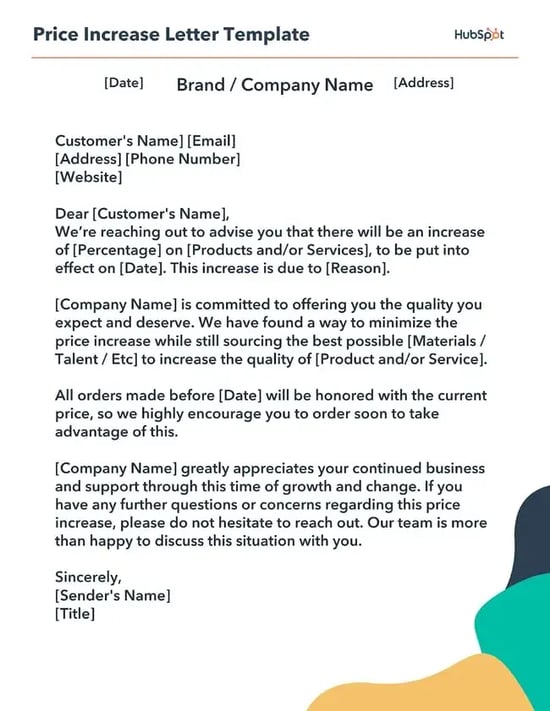
Keep in mind that you‘ll want to adhere to the tone that you’ve set during the customer relationship so far, while being transparent and personal every step of the way. Templates can help provide the necessary professional context for price increases and other challenging topics, but be sure to customize them for maximum impact.
Click here to download a free price increase letter template, available exclusively in HubSpot's 50 Customer Service Email Templates Kit.
How to Write a Price Increase Letter
Announcing a price increase can be a delicate task. I’ve learned from experience, whether it’s for a SaaS or an e-commerce product, that a simple, clear structure is what works best. You need to balance being direct with being empathetic and confident. The goal is to guide your customer through the change and remind them why they’re with you.
Get right to the point.
I believe in being direct. Your customers are busy, and they’ll appreciate you not wasting their time. In the first paragraph, I always state exactly what is changing.
For example, at Skybound, if a shipping rate to a specific country was changing due to new tariffs, I would state that plainly upfront, along with the date it would take effect. This prevents any confusion.
Acknowledge their feelings.
I always make it a point to show I understand their position. A simple, empathetic line like, “We know price changes are never easy to hear, so we wanted to be upfront about this change and give you plenty of notice” shows you’re thinking about them. It validates their potential frustration without weakening your decision.
Don’t apologize for the value.
This is a very critical distinction I’ve had to learn. While I’m empathetic about the inconvenience, I avoid apologizing for the price change itself. Saying “we’re sorry” can make it sound like you’re doing something wrong. You are making a necessary business decision to sustain and improve the quality your customers rely on. I prefer to use confident, forward-looking language like, “This adjustment allows us to continue investing in the service you count on.”
Provide an escape hatch (or an incentive).
For long-term customers, a price increase can feel like a penalty for their loyalty. One of the most effective strategies I’ve seen is offering them a way to lock in their current rate for an extended period, for instance, if they switch from a monthly to an annual plan. This rewards loyalty, gives them a sense of control, and can actually improve your cash flow and reduce churn. It turns a mandatory price increase into somewhat of a choice.
Make it easy to get answers.
I’ve learned that no matter how well you write the announcement, some customers will have questions. I never make them hunt for answers. At Skybound, I make sure we end our messages by clearly stating how they can get more information. I’ll often provide a direct link to the specific help center article that explains the complexities of international shipping, showing that we’re prepared and willing to continue the conversation.
Send a reminder.
People are busy and one message will be missed. I always schedule a short, simple reminder to be sent about one to two weeks before the effective date. It’s a respectful and professional courtesy that I find prevents customers from being caught by surprise when they see their next bill.
Don’t think of the price increase letter as delivering bad news, think of it as a critical moment to reinforce the value of your partnership.
Price Increase Letter Examples
You have the tips. You have the templates. How do they work in real life? If you are a paid member of any subscription service, chances are you have received one or two price increase letters in your email inbox. Amazon Prime is a popular company that you may have seen rising prices in recent years. They are not the only ones. Let’s take a look at examples from Spotify, Disney+, Upwork, Hulu, and Netflix.
1. Fabletics
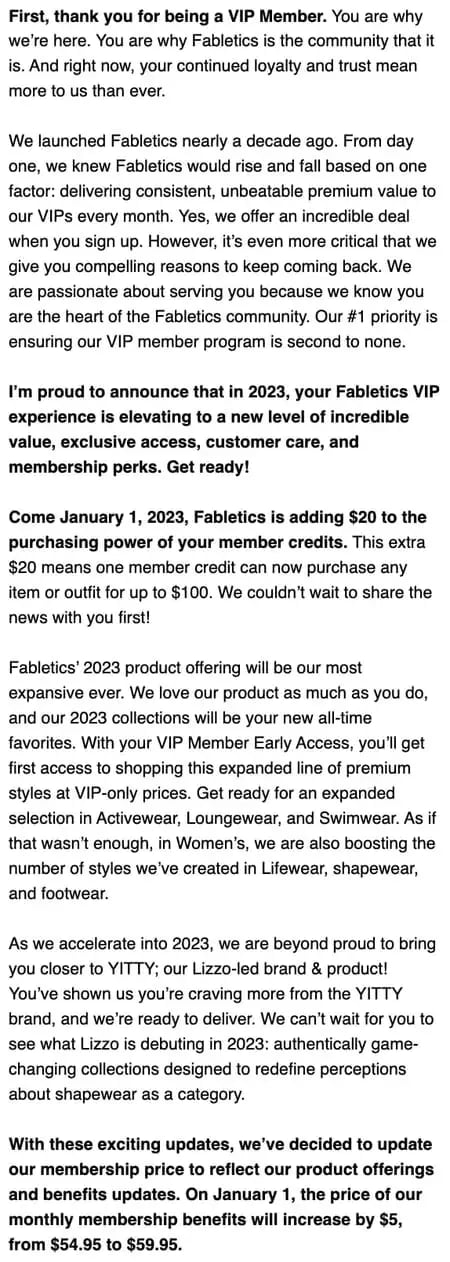
Fabletics emailed its VIP members about an upcoming $5 price increase. The athleisure brand offers a monthly membership where members can purchase new outfits and clothing each month.
While this price increase letter is significantly longer than the other examples on this list, it‘s great at conveying the value members will get along with the increase. It starts by telling members what’s in it for them: an added $20 in purchasing power each month. Now for $59.95 per month, members can earn up to $100 in merchandise each month.
The email reiterates multiple perks membership offers in addition to highlighting new collaborations with Lizzo. So instead of focusing on the price increase, attention is now directed to all the value membership provides.
2. Apple
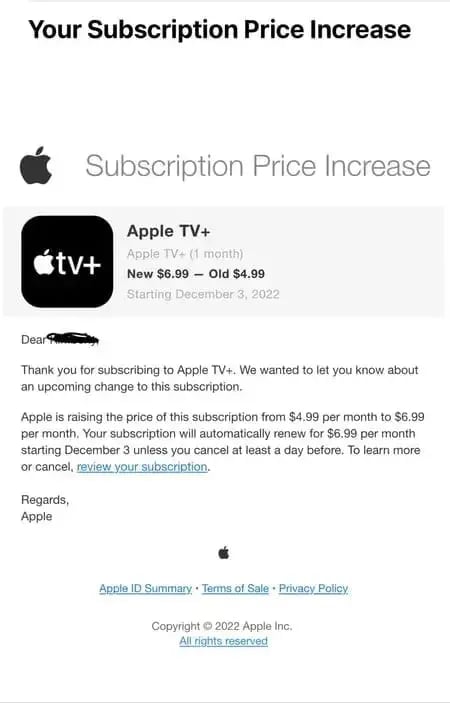
Apple sent an email informing customers of a price increase to $6.99 (previously $4.99) for its Apple TV+ subscription.
The streaming platform notified customers directly via email and gave customers several weeks to decide between keeping or canceling a subscription. This price increase letter closes with a call-to-action for customers to revisit their subscription.
Short, sweet, and to the point, this price increase email is an ideal example to imitate when you write your own letter.
3. Upwork

Upwork, one of the largest freelancing websites, announced a price increase to its Freelancer fee structure. Since the change involved an increase for both freelancers and clients, the announcement posted on the website had to be thorough.
To explain the reasoning behind the price increase, Upwork includes an FAQ section that gives quick answers to common questions about the change, and where to go for more information.
At the close, this email does not prompt freelancers to reach out with further questions, but it does direct them to learn more about the changes happening to their membership. With Upwork being a platform where freelancers spend and make money, this price increase letter covers enough touchpoints to efficiently introduce customers to the change.
4. Hulu

When I look at this email from Hulu, I see a very straightforward approach. They get the essential details out there right away. You know the new price and the exact date it starts, which is good. They also give you links to manage your subscription, so they’re not trying to hide the cancel button, which I appreciate.
But for me, this email is missing something important. It’s all business. It delivers the news but doesn’t make any effort to remind you why you’re a subscriber in the first place. There’s no mention of what’s great to watch or what’s coming up. Because it focuses only on the cost, it almost invites you to think about the subscription in terms of cost alone, and that’s a risky move for any company.
5. Netflix
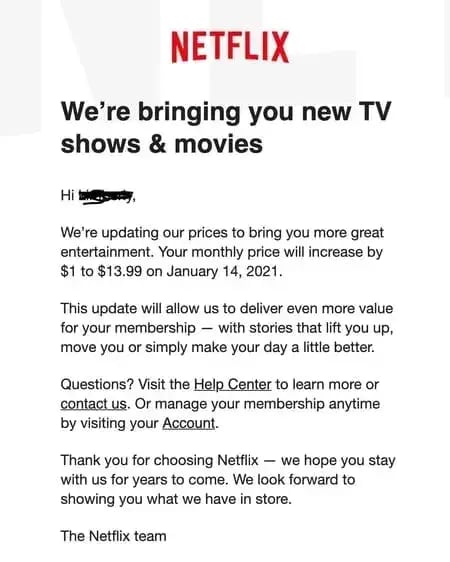
Netflix took a much more effective approach in their price increase messaging. Like Hulu, they sent notice well in advance but also took the opportunity to remind customers how their service adds value.
“This update will allow us to deliver even more value for your membership: with stories that lift you up, move you, or simply make your day a little better.” It perfectly sums up why customers should stick around despite the increase.
Overall, Netflix’s tone is warm and personable while still hitting all the best practices listed above. To further retain customers, the company added a list of new releases and top picks in the footer, showing them all the great content they’ll miss out on if they were to cancel their subscription.
How to Raise Prices without Losing Customers
These conversations are never easy, but my experience at Greenhouse and Skybound has shown that they don’t have to break your customer relationships. A well-handled price increase can actually reinforce why customers chose you in the first place.
Success here isn’t complicated. It comes down to being relentlessly honest about your “why.” Whether it’s rising costs or increased product value, frame the entire conversation around the benefits to your customer, not your own expenses.
Ultimately, if you approach this moment with transparency and a clear focus on the value you provide, you position the change from an unwarranted price increase to a clear investment in a better product and service offering.
Editor's note: This post was originally published in March 2019 and has been updated for comprehensiveness.
.png?width=112&height=112&name=Image%20Hackathon%20%E2%80%93%20Vertical%20(67).png)

.png)
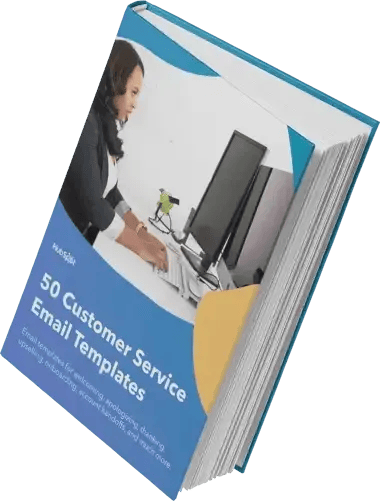
![24 best contact us pages you'll want to copy [+ templates]](https://53.fs1.hubspotusercontent-na1.net/hubfs/53/contact-us-page-1-20251028-243229.webp)

![How to Respond to Customer Complaints [+Complaint Response Examples]](https://53.fs1.hubspotusercontent-na1.net/hubfs/53/Copy%20of%20Featured%20Image%20Template%20Backgrounds%20(8)-1.png)


![How to Write an Apology Letter to Customers [12 Templates & Examples]](https://53.fs1.hubspotusercontent-na1.net/hubfs/53/ai%20customer%20service%20predictions%20(6).png)



